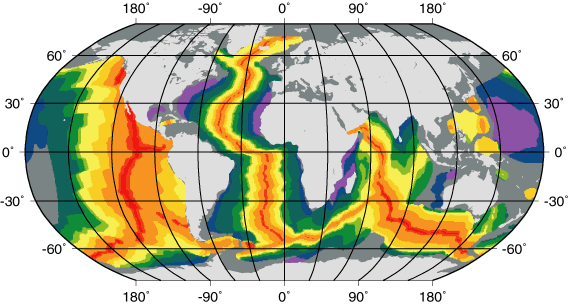Samples collected from the ocean floor show that the age of oceanic crust increases with distance from the spreading centre important evidence in favour of this process.
Is the age of the ocean floor constant.
Although the age of the ocean floor roughly corresponds to the amount of sediment accumulation dating the seafloor and its sediments is not a good way to estimate the age of the earth as humphreys 2005 implies.
Oceanic crust is the uppermost layer of the oceanic portion of a tectonic plate it is composed of the upper oceanic crust with pillow lavas and a dike complex and the lower oceanic crust composed of troctolite gabbro and ultramafic cumulates.
Ige table 5r below indicates the entire surface of the planet is rising outwardly at the present accelerating rate of 2 85 cm each year 6378 96 km.
The magma located under the solid crust is lifting the continents and the ocean floor s.
The crust overlies the solidified and uppermost layer of the mantle the crust and the solid mantle layer together constitute oceanic lithosphere.
Because of this correlation between age and subduction potential very little ocean floor is older than 125 million years and almost none of it is older than 200 million years.
It is important to note that according to evolutionary uniformitarian geologists the last 30 million years were the time of considerable continental denudation.
Continental shelf 300 feet continental slope 300 10 000 feet abyssal plain 10 000 feet abyssal hill 3 000 feet up from the abyssal plain seamount 6 000 feet.
The following features are shown at example depths to scale though each feature has a considerable range at which it may occur.
These age data also allow the rate of seafloor spreading to be determined and they show that rates vary from about 0 1 cm 0 04 inch per year to 17 cm 6 7 inches per year.
This graphic shows several ocean floor features on a scale from 0 35 000 feet below sea level.
The cracks created by the uplifting fill with pressurized lava that cools and solidifies as new crust.
Because the seafloor is constantly being created and destroyed the ocean floor is actually much younger than the earth as a whole.
50 km per year.
Radiometric dating of a magnetic anomaly stripe of rock that is 225 km away from the mid ocean ridge axis gives an age of 4 5 million years.
To get the dependence on x one must substitute t x v ax l where l is the distance between the ridge to the continental shelf roughly half the ocean width and a is the ocean basin age.
Assuming a constant rate seafloor spreading in this area occurs at a rate of choose one.
This dataset shows the age of the ocean floor along with the labeled tectonic plates and boundaries.
In only 30 million years assuming constant rate of erosion all the ocean sediments could have accumulated this age does not square with the over 1 billion year age assumed by evolutionary uniformitarian geologists.
20 000 cm per year.
For that geologists date and study continental crust.
Rather than height of the ocean floor above a base or reference level the depth of the ocean is of interest.
Therefore seafloor dating isn t that useful for studying plate motions beyond the cretaceous.
5 cm per year.


















